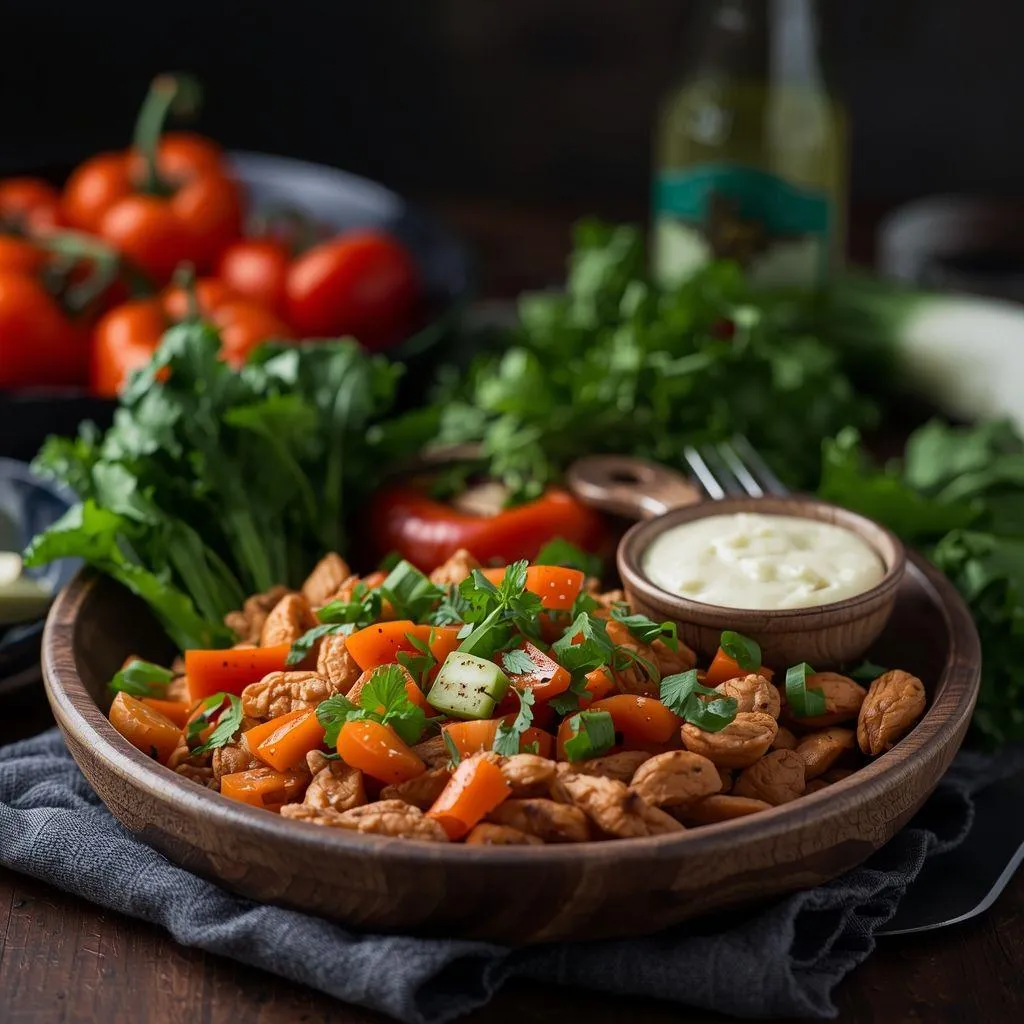- Tomasz Jankowski
- November 03, 2025
- 8min.
- Report
15 Less Popular but Healthy Vegetables
Table of Contents
1. Baklajan, also known as the love fruit, eggplant, or long nightshade, is a vegetable hailing from the nightshade family.
Baklajan is a low-calorie vegetable that provides more than 20 calories in a serving of 100 g. Its flesh is a source of significant amounts of magnesium, potassium, and calcium. It is also an excellent source of dietary fiber, providing almost twice as much as peaches or apples. Baklajan contains vitamins A, B, and C. The vegetable has strong anticancer properties, mainly due to the large amount of antioxidants. The antiangiogenic effect of nasunin, a substance found in the skin of baklajan, is particularly important. Eating baklajan can improve metabolic performance, increase protection against heart disease, and prevent the development of cancer. Due to the fiber of baklajan, it is used in therapy aimed at improving the functioning of the digestive system and reducing cholesterol levels. The detoxifying nature of the plant can be utilized in detox diets.2. Brukive Plant
Karpiel, also known as Brukive, is a popular vegetable and a variant of Rüppelkapst. Due to its high water content and significant amounts of vitamins B and C, nutritionists recommend Brukive for those looking to lose weight. It is a low-calorie plant that can often serve as a food supplement. However, it is important to be mindful not to overconsume it, as the large amounts of cyanide present in Brukive can lead to hypothyroidism due to the inhibition of iodine transport.3. Absolutely Bob
Bob is a legume that, owing to its low fat content and high fiber content, is ideal for weight loss diets. However, it is important to note that it is not a low-calorie plant, as a standard serving of 100 g provides almost 110 kcal. Large amounts of folic acid and B vitamins have a positive effect on the regulation of the nervous system. Regular consumption of Bob allows for the coverage of more than 100% of the daily requirement for folic acid, which contributes to a healthy pregnancy and a reduced likelihood of developmental abnormalities in the fetus. The aforementioned vitamin compounds, in combination with iron, can be particularly beneficial in the case of anemia, as they are involved in the synthesis of new erythrocytes. Another important aspect of Bob is the high protein content (7.6 g of protein in 100 g of cooked Bob). The high potassium content and low sodium levels contribute to a positive regulation of cholesterol levels.4. Common pea
The ordinary pea variety, commonly known as green pea, originates from territories of North Africa, Asia, Eastern and Southern Europe, and the Caucasus. It is now extensively cultivated in most world regions. The most nutritious properties of green peas are obtained through consuming them raw. This vegetable comprises a multitude of health-promoting components, including beta-carotene, fiber, vitamins (B, C, and E) and microelements such as phosphorus, potassium, calcium, and iron.5. Cabbage variety referred to as Garlic
Garlic is a variety of cabbage that is identified by its long and very wrinkled leaves. It is mainly cultivated as a crop plant. It is often regarded as an ornamental plant due to its leaves in various colors (green, purple, brown). It is also known for its high content of antioxidants such as beta-carotene, lutein, and zeaxanthin, which greatly improve the functioning of the organ and aid in the removal of toxic compounds from the body. Garlic also contains substantial amounts of fiber and mineral salts such as potassium and calcium, which help safeguard the cardiovascular system and the digestive system.6. Cucumber-Pumpkin Hybrid Vegetable
This vegetable is a hybrid of two other vegetables - cucumber and pumpkin. The greatest benefits for the body are provided by young fruits of this vegetable, which are characterized by soft flesh and light, delicate skin. Why should they be consumed? Firstly, this vegetable stands out for its low calorie content - a 100-gram serving provides only 15 kcal. The fruits of this vegetable do not accumulate excessive amounts of harmful heavy metals. They contain beta-carotene, vitamins B and C, as well as phosphorus, potassium, and calcium. Furthermore, this vegetable exhibits diuretic properties.7. Substitute, with a thickness of no more than 10 mm
Kalarepa is another variety of vegetable cabbage that, like jarmush, is a cultivated plant. Wild-growing kalarepa is rarely encountered. In Poland, it is one of the most commonly grown crops, yet it is not very frequently seen on tables. This is a pity, as it contains many valuable components. Apart from vitamins A, B, and C, as well as micronutrients such as phosphorus, iodine, magnesium, manganese, copper, potassium, calcium, or iron, it also contains other beneficial compounds such as pantothenic acid, which regulates various processes in the body, including promoting wound healing, aiding digestion, circulation, and the nervous system, as well as improving skin pigmentation and hair condition.8. Patison – a less popular pumpkin variety
Patison is a less recognized variety of the common pumpkin that was introduced to Europe by Spanish travelers during their voyages to North America. It is a very versatile vegetable that can be utilized as a filling, for preparing meat dishes such as goulash, or as an ingredient in lunches and salads. Due to its low caloric value (17 kcal/100 g), it is frequently employed as a component of weight-loss diets and can be used as a substitute for products with higher fat content. Patison is rich in beta-carotene, phosphorus, magnesium, iron, and vitamins B1, B2, and C.9. Shepherd's Joy
Babka zwyczajna, also known as Shepherd's Joy, is a plant belonging to the celery family. Its natural habitat is in the regions of Europe and Asia, but it has spread worldwide over time. It was once widely used in Polish cuisine. This vegetable contains nutritious components such as protein, phosphorus, potassium, calcium, iron, and vitamins B and C. The plant also exhibits strong detoxifying and diuretic properties, making it particularly recommended for individuals suffering from kidney or bladder issues or rheumatic diseases. However, due to its high-calorie content, it is not recommended to use this vegetable during weight loss attempts.10. Here are the findings from the evaluation:
Fermented rhubarb is recognized for its tangy and sour taste, its leaves are red-pink. 100 grams of fermented rhubarb provide the body with 20 calories and a significant amount of fiber, making the use of this vegetable particularly appropriate for individuals struggling with weight management. Moreover, fermented rhubarb contains healthy components such as phosphorus, magnesium, iron, beta-carotene, or vitamin C. Fermented rhubarb contains rapontigenin, a very potent compound belonging to polyphenols, whose ability to decrease the division rate of cancer cells has been scientifically proven. This compound also exhibits anti-allergic properties and enhances the function of the circulatory system. Another compound found in fermented rhubarb is raponticin – a substance with strong estrogenic effects, which is of great importance for women in menopause and teenagers grappling with acne. However, fermented rhubarb is not recommended for men with testosterone deficiency, as it may aggravate this deficiency.11. Rueva Plant
The Rueva Plant is acknowledged as a plant belonging to the cabbage family. It is particularly suggested for individuals displaying symptoms of avitaminosis – a condition arising from deficiencies in vital nutrients caused by disease, treatment, or other factors. Due to its plentiful amount of beta-carotene and vitamins C and E, the vegetable demonstrates very potent antioxidant properties, which effectively counteract the development of numerous unhealthy conditions and the worsening of health.12. The turnip
The turnip, often referred to as a typical cabbage, is a root vegetable rich in sulphur. The mustard glycosides present in the roots are responsible for the characteristic taste and smell of turnips. The compounds found in the roots improve blood circulation in the skin and stimulate the production of certain secretions, such as digestive juices, saliva, and bile. In addition, phytocides present in turnips protect the body from the growth of pathogenic microorganisms and disease-causing microbes. Turnips are also rich in other nutrients such as phosphorus, magnesium, potassium, calcium, and iron. The high content of vitamins B1, B2, C, and PP confirms the health benefits associated with consuming this vegetable.13. This Regulation shall come into force on the twentieth day following its publication in the Official Journal of the European Union
The term 'salep' originates from the Turkish language and refers to both a popular drink and the bulbs of the male stork from which the drink is prepared. This term is often referred to as Chinese ginseng. Salep is a natural stimulant that is primarily used to treat digestive disorders such as diarrhea, dryness of the esophagus, and digestive problems. Additionally, salep is also frequently used as a warming and soothing agent.14. For the purpose of this Regulation, the following terms shall apply:
Schwärzling is a plant from the astrolabe family, native to mainly southern and central Europe and certain areas of Asia. Currently, it is cultivated only in some regions. The edible part of this vegetable is the root, covered with black skin, revealing a white flesh after peeling. The flavor of Schwärzling is reminiscent of popular asparagus. In addition to mineral salts and vitamins, it contains nicotinic acid, which plays a crucial role in the synthesis and breakdown of many substances, such as amino acids, fatty acids, and carbohydrates. Moreover, it has the ability to expand blood vessels and inhibit the toxic effects of some chemical compounds and drugs.15. Fresh Produce of Fruit and Vegetables, a member of the Buckwheat family
Kwasica, a member of the buckwheat family, is found almost everywhere with a temperate climate. It is one of the principal sources of beta-carotene (a 100g portion of this plant will cover more than 75% of daily demand). This compound is an excellent antioxidant that cleanses the body and delays the aging process. Furthermore, kwasica contains rutin, which significantly enhances the condition of blood vessels and supports antioxidant processes. It is also important to note that excessive consumption of kwasica can be detrimental to the body due to the presence of oxalic acid, as an excess of it can lead to impaired calcium absorption and the formation of insoluble crystals of oxalate.












